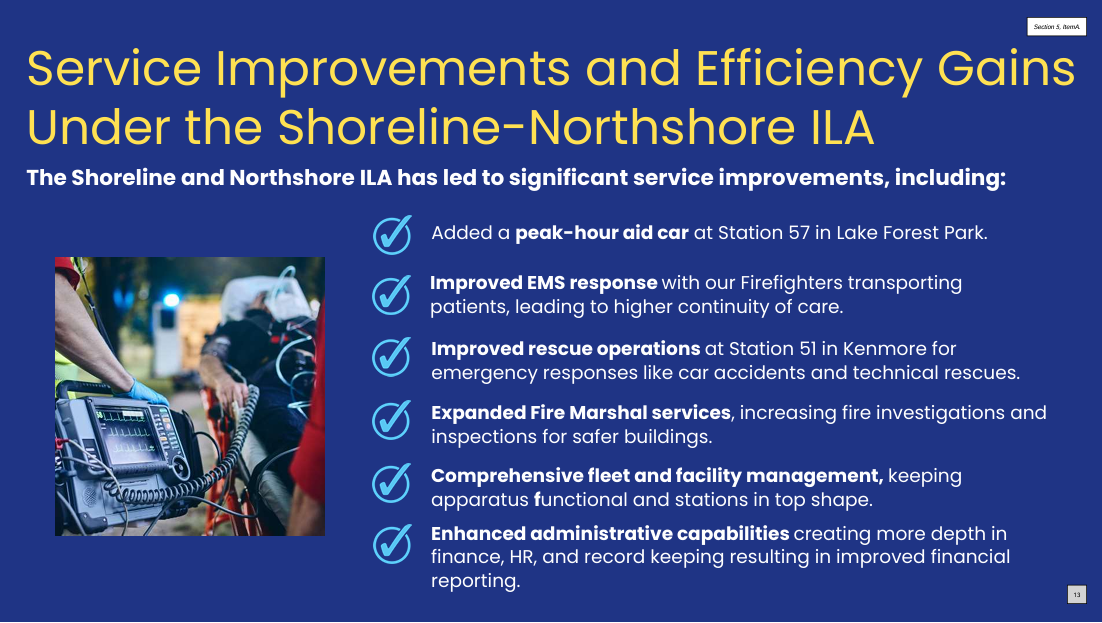Today, we have the best of both worlds:
A consolidated fire service that saves us money and performs at a high level;
while still providing each community with the ability to tailor services
to their needs,
set their own reserve fund goals and tax rates,
and retain ownership of their facilities, apparatus, and reserve funds.
Our communities are different and have different service needs.
Currently, each district has its own Board of Commissioners, elected by their own voters,
responsible for setting the service-level requirements and tax policy for their district.
With the RFA there will be only a single board of Commissioners.
A single region-wide service-level and tax rate will result in loss of local control.
There will be no contractual performance requirements or metrics.
Accountability will be lost.
There is nothing that the RFA can do that the individual Boards of Fire Commissioners cannot already do.
What is to gain? Why should we experiment with something new and unproven?
The Shoreline and Kenmore communities both incorporated as cities because King County was providing a single standard of service for all of King County.
The county standard did not meet the communities' needs.
The formation of the cities brought local control that matched services with needs
and assured that the costs were in sync with the benefits.
Local leaders were now accountable for the results.
Why would we go back to a single standard of service now?
The RFA results in loss of accountability
The existing contract for fire service (ILA):
- Requires specific service delivery at a specific cost
- Lets local communities tailor services to match their needs.
- Requires quality performance
- Can be modified to address new needs or concerns
- Provides for resolution of disputes
- Allows for competitive service providers at contract renewal
- Incentivizes a high level of employee performance
(A satisfied customer remains while a dissatisfied customer may leave.)
Under an RFA all of these performance guarantees will be lost.
There are no performance requirements or metrics under the RFA.
The RFA reduces local control
Now, each fire district's Board of Commissioners is elected by the voters in that district.
We are represented by Fire Commissioners who live here.
They tailor services to our community needs.
Today there is equity.
Each community is assured it receives the services it desires, pays for the services it receives, and collects the revenue generated from its taxpayers.
We own our Fire Stations, Fire Engines, Aid Cars, and Reserve Funds.
Under the RFA, there will be only a single Board of Commissioners.
The RFA will result in loss of flexibility
Our communities are different and have different service needs:
Shoreline is a fast-growing community with a large percentage of commercial multi-family /multi-story buildings.
This area has a much higher call demand.
I-5, SR 99, and Sound Transit are key drivers of growth for call demand.
The Northshore Fire District serves Lake Forest Park and Kenmore.
These communities are growing more slowly and consist mostly of single-family neighborhoods with low-rise apartments and condos.
Call demand is relatively low and stable.
As things stand, each district can set its own service levels and tax rates.
Shoreline imposes a fire mitigation fee for new construction.
This helps pay for new capital projects.
These funds are needed to support a fast-growing demand for fire responses.
Shoreline mitigation fees can only be used for capital projects within the City of Shoreline.
A Northshore Fire District focus is encouraging fire sprinkler systems in all new construction.
This program provides incentives for upgrading existing buildings:
a 50% discount of the ‘Fire Fee’ (Fire Benefit Charge) is granted to the owners of structures with fire sprinkler systems.
The principle is that ‘Nobody dies is a sprinklered building’
and a sprinklered building requires fewer fire department resources as fires are typically limited to a single room.
Shoreline provides a 10% ‘Fire Fee’ discount for sprinklered buildings.
References
Here is some data from the King County Assessor's Localscape website that illustrate the differences between regions:
Northshore Fire District

Shoreline Fire District





